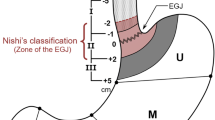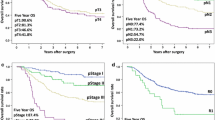Abstract
Background
Since Misumi et al. and Siewert proposed a new classification for carcinoma of the gastroesophageal junction (GEJ), few surgical studies using these criteria have been reported from Eastern countries. Siewert type II adenocarcinomas are managed using general rules for either gastric or esophageal cancer. We set out to determine whether type II adenocarcinoma is a distinct clinical entity requiring a more specific treatment plan.
Methods
Among 125 Japanese patients who underwent resection of adenocarcinoma of the GEJ (type I, 2; type II, 44; type III, 79), 101 who underwent R0 resections (type II, 40; type III, 61) were analyzed to evaluate surgical results and compare clinicopathologic factors.
Results
Barrett’s epithelium was recognized in two patients with type II adenocarcinoma. Type II differed significantly from type III in higher prevalence of Borrmann macroscopic type 2, more frequent lymph node metastasis (58% vs. 34%), higher metastatic rate to lower mediastinal lymph nodes (13%), increased risk of hepatic recurrence, and lower 5-year survival after R0 resection (67.4% vs. 87.1%).
Conclusions
Clinicopathologic differences were evident between type II and III adenocarcinomas. Siewert type II adenocarcinoma differs sufficiently to be considered a clinical entity distinct and independent from type III.





Similar content being viewed by others
References
Clark GW, Peters JH, Ireland AP, et al. Nodal metastasis and sites of recurrence after en bloc esophagectomy for adenocarcinoma. Ann Thorac Surg 1994;58:646–653
Wright CD, Mathisen DJ, Wain JC, et al. Evolution of treatment strategies for adenocarcinoma of the esophagus and gastroesophageal junction. Ann Thorac Surg 1994;58:1574–1578
Millikan KW, Silverstein J, Hart V, et al. A 15-year review of esophagectomy for carcinoma of the esophagus and cardia. Arch Surg 1995;130:617–624
Tachimori Y, Kato H, Watanabe H, et al. Difference between carcinoma of the lower esophagus and the cardia. World J Surg 1996;20:507–510
Nishi M, Nomura H, Kajisa T, et al. Surgical problem of carcinoma in the esophagogastric junction (in Japanese with English abstract). Stomach and Intestine 1978;13:1497–1507
Nakane Y, Okamura S, Boku T, et al. Prognostic differences of adenocarcinoma arising from the cardia and the upper third of the stomach. Am Surg 1993;59:423–429
Ohno S, Tomisaki S, Oiwa H, et al. Clinicopathologic characteristics and outcome of adenocarcinoma of the human gastric cardia in comparison with carcinoma of other regions of the stomach. J Am Coll Surg 1995;180:577–582
Okabayashi T, Gotoda T, Kondo H, et al. Early carcinoma of the gastric cardia in Japan: is it different from that in the West? Cancer 2000;89:2555–559
Misumi A, Murakami A, Harada K, et al. Definition of carcinoma of the gastric cardia. Langenbecks Arch Chir 1989;374:221–226
Siewert JR, Stein HJ. Carcinoma of the cardia: carcinoma of the gastroesophageal junction―classification, pathology and extent of resection. Dis Esophagus 1996;9:173–182
Powell J, McConkey CC. Increasing incidence of adenocarcinoma of the gastric cardia and adjacent sites. Br J Cancer 1990;62:440–443
Devesa SS, Blot WJ, Fraumeni JF Jr. Changing patterns in the incidence of esophageal and gastric carcinoma in the United States. Cancer 1998;83:2049–2053
Ozawa S, Ando N, Kitagawa Y, et al. Does incidence of carcinoma of the esophagogastric junction increase (in Japanese with English abstract)? Nippon Geka Gakkai Zasshi 1998;99:542–546
Kodera Y, Yamamura Y, Shimizu Y, et al. Adenocarcinoma of the gastroesophageal junction in Japan: relevance of Siewert’s classification applied to 177 cases resected at a single institution. J Am Coll Surg 1999;189:594–601
Nakamura T, Ide H, Eguchi R, et al. Adenocarcinoma of the esophagogastric junction: a summary of responses to a questionnaire on adenocarcinoma of the esophagus and the esophagogastric junction in Japan. Dis Esophagus 2002;15:219–225
Ichikura T, Ogawa T, Kawabata T, et al. Is adenocarcinoma of the gastric cardia a distinct entity independent of subcardial carcinoma? World J Surg 2003;27:334–338
Siewert JR, Feith M, Werner M, et al. Adenocarcinoma of the esophagogastric junction: results of surgical therapy based on anatomical / topographic classification in 1,002 consecutive patients. Ann Surg 2000;232:353–361
Mariette C, Castel B, Toursel H, et al. Surgical management of and long-term survival after adenocarcinoma of the cardia. Br J Surg 2002;89:1156–1163
Ito H, Clancy TE, Osteen RT, et al. Adenocarcinoma of the gastric cardia: what is the optimal surgical approach? J Am Coll Surg. 2004;199:880–886
Fein M, Fuchs KH, Ritter MP, et al. Application of the new classification for cancer of the cardia. Surgery 1998;124:707–713
Peracchia A, Bonavina L, Incarbone R, et al. Results of surgical therapy in patients with adenocarcinoma of the esophagus and cardia. Gastric Cancer 1999;2:89–94
Hulscher JB, Van Sandick JW, Offerhaus GJ, et al. Prospective analysis of the diagnostic yield of extended en bloc resection for adenocarcinoma of the esophagus or gastric cardia. Br J Surg 2001;88:715–719
Japanese Gastric Cancer Association. Japanese classification of gastric carcinoma, 2nd English edition. Gastric Cancer 1998;1:10–24
Sobin LH, Wittekind C, International Union Against Cancer. (UICC), eds, TNM Classification of Malignant Tumors. 5th ed. New York: John Wiley & Sons, Inc., 1997
Fleming ID, American Joint Committee on Cancer Classification (AJCC), eds, AJCC Cancer Staging Manual. Philadelphia: Lippincott Williams & Wilkins, 1997
Akiyama H, Miyazono H, Tsurumaru M, et al. Thoracoabdominal approach for carcinoma of the cardia of the stomach. Am J Surg 1979;137:345–349
Kaplan EL, Meier P. Nonparametric estimation from incomplete observations. J Am Stat Assoc 1958;53:457–481
Gehan EA. A generalized Wilcoxon test for comparing arbitrarily singly-censored samples. Biometrika 1965;52:203–224
Dresner SM, Lamb PJ, Bennett MK, et al. The pattern of metastatic lymph node dissemination from adenocarcinoma of the esophagogastric junction. Surgery 2001;129:103–109
Aikou T, Shimazu H. Difference in main lymphatic pathways from the lower esophagus and gastric cardia. Jpn J Surg 1989;19:290–295
De Manzoni G, Pedrazzani C, Pasini F, et al. Pattern of recurrence after surgery in adenocarcinoma of the gastroesophageal junction. Eur J Surg Oncol 2003;29:506–510
Sadahiro S, Suzuki T, Ishikawa K, et al. Prophylactic hepatic arterial infusion chemotherapy for the prevention of liver metastasis in patients with colon carcinoma: a randomized control trial. Cancer 2004;100:590–597
Sons HU, Borchard F. Cancer of the distal esophagus and cardia. Incidence, tumorous infiltration, and metastatic spread. Ann Surg 1986;203:188–195
Husemann B. Cardia carcinoma considered as a distinct clinical entity. Br J Surg 1989;76:136–139
Stipa S, Di Giorgio A, Ferri M. Surgical treatment of adenocarcinoma of the cardia. Surgery 1992;111:386–393
Mattioli S, Di Simone MP, Ferruzzi L, et al. Surgical therapy for adenocarcinoma of the cardia: modalities of recurrence and extension of resection. Dis Esophagus 2001;14:104–109
Heidl G, Langhans P, Mellin W, et al. Adenocarcinomas of esophagus and cardia in comparison with gastric carcinoma. J Cancer Res Clin Oncol 1993;120:95–99
Author information
Authors and Affiliations
Corresponding author
Rights and permissions
About this article
Cite this article
Yuasa, N., Miyake, H., Yamada, T. et al. Clinicopathologic Comparison of Siewert Type II and III Adenocarcinomas of the Gastroesophageal Junction. World J. Surg. 30, 364–371 (2006). https://doi.org/10.1007/s00268-005-0434-x
Published:
Issue Date:
DOI: https://doi.org/10.1007/s00268-005-0434-x




